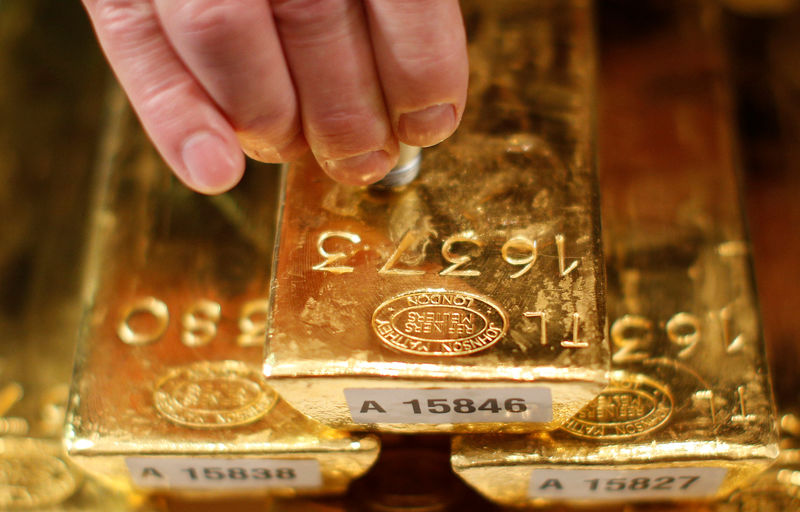* Gold down 1.4% this week, silver 2.6%
* Platinum on track for biggest weekly decline since June
* Dollar heads for its strongest week since May
* Interactive graphic tracking global spread of the
coronavirus: https://tmsnrt.rs/3aIRuz7
in an external browser
(Updates prices)
By Diptendu Lahiri and Nakul Iyer
Sept 4 (Reuters) - Gold rose on Friday as the dollar's rally
stalled, with investor focus turning to U.S. jobs data later in
the day, though bullion was still down over the week.
Spot gold XAU= was up 0.4 % at $1,937.96 an ounce by 1137
GMT.
But the metal was still on course for a 1.4% decline over
the week, driven by earlier gains in the dollar coupled with
some upbeat data including robust manufacturing figures from the
United States and elsewhere, which kindled hopes for a fast
revival from the COVID-19 pandemic-induced economic slump.
U.S. gold futures GCv1 rose 0.4% to $1,945.70 an ounce.
"The job report will set the stage for all asset classes,"
said Saxo Bank analyst Ole Hansen.
"If the equity markets close on a weaker note after the
report, and given the U.S. is heading into a long weekend, we
might see some strength in gold."
The dollar index .DXY steadied, taking a breather from a
rally that set the greenback on track for its best week since
mid-May. USD/
"Since the recovery, movement in USD has stopped for the
moment. That is a positive element for gold," said ActivTrades
chief analyst Carlo Alberto De Casa.
A weaker dollar makes gold cheaper for holders of other
currencies.
Global equities edged lower as attention turned to the U.S.
non-payroll figures due at 1230 GMT, with markets expecting
payrolls to have grown by 1.4 million in August, compared with
1.763 million jobs created the previous month. MKTS/GLOB
Gold, which has gained 27% this year, is still strong but
"in need of a deeper correction", Saxo bank's Hansen said.
Elsewhere, silver XAG= gained 0.6% to $26.78 an ounce but
has shed 2.6% over the week, while palladium XPD= dipped by
0.1% to $2,282.67.
Platinum XPT= rose 1.6% to $903.38 an ounce but was on
track for its worst week since mid-June, down more than 2.8%.
- English (USA)
- English (UK)
- English (India)
- English (Canada)
- English (Australia)
- English (South Africa)
- English (Nigeria)
- Deutsch
- Español (España)
- Español (México)
- Français
- Italiano
- Nederlands
- Português (Portugal)
- Polski
- Português (Brasil)
- Русский
- Türkçe
- العربية
- Ελληνικά
- Svenska
- Suomi
- עברית
- 日本語
- 한국어
- 简体中文
- 繁體中文
- Bahasa Indonesia
- Bahasa Melayu
- ไทย
- Tiếng Việt
- हिंदी
PRECIOUS-Gold gains as dollar stalls, with focus on U.S. data
Published 09/04/2020, 05:59 PM
Updated 09/04/2020, 08:10 PM
PRECIOUS-Gold gains as dollar stalls, with focus on U.S. data

Latest comments
Install Our App
Risk Disclosure: Trading in financial instruments and/or cryptocurrencies involves high risks including the risk of losing some, or all, of your investment amount, and may not be suitable for all investors. Prices of cryptocurrencies are extremely volatile and may be affected by external factors such as financial, regulatory or political events. Trading on margin increases the financial risks.
Before deciding to trade in financial instrument or cryptocurrencies you should be fully informed of the risks and costs associated with trading the financial markets, carefully consider your investment objectives, level of experience, and risk appetite, and seek professional advice where needed.
Fusion Media would like to remind you that the data contained in this website is not necessarily real-time nor accurate. The data and prices on the website are not necessarily provided by any market or exchange, but may be provided by market makers, and so prices may not be accurate and may differ from the actual price at any given market, meaning prices are indicative and not appropriate for trading purposes. Fusion Media and any provider of the data contained in this website will not accept liability for any loss or damage as a result of your trading, or your reliance on the information contained within this website.
It is prohibited to use, store, reproduce, display, modify, transmit or distribute the data contained in this website without the explicit prior written permission of Fusion Media and/or the data provider. All intellectual property rights are reserved by the providers and/or the exchange providing the data contained in this website.
Fusion Media may be compensated by the advertisers that appear on the website, based on your interaction with the advertisements or advertisers.
Before deciding to trade in financial instrument or cryptocurrencies you should be fully informed of the risks and costs associated with trading the financial markets, carefully consider your investment objectives, level of experience, and risk appetite, and seek professional advice where needed.
Fusion Media would like to remind you that the data contained in this website is not necessarily real-time nor accurate. The data and prices on the website are not necessarily provided by any market or exchange, but may be provided by market makers, and so prices may not be accurate and may differ from the actual price at any given market, meaning prices are indicative and not appropriate for trading purposes. Fusion Media and any provider of the data contained in this website will not accept liability for any loss or damage as a result of your trading, or your reliance on the information contained within this website.
It is prohibited to use, store, reproduce, display, modify, transmit or distribute the data contained in this website without the explicit prior written permission of Fusion Media and/or the data provider. All intellectual property rights are reserved by the providers and/or the exchange providing the data contained in this website.
Fusion Media may be compensated by the advertisers that appear on the website, based on your interaction with the advertisements or advertisers.
© 2007-2024 - Fusion Media Limited. All Rights Reserved.